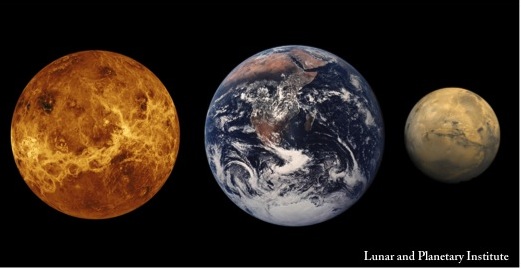Did a Wandering Jupiter Stunt Growth of Mars?

The migration of the planet Jupiter as the solar system formed may have kept Mars the planetary runt, smaller than its rocky neighbors Earth and Venus, that it is today, a new study suggests.
Mars is only about half the size of Earth and one-tenth the mass of our planet — a fact that has so far perplexed scientists. But in the new study, researchers calculated that Jupiter's movement might have been responsible for the odd setup.
"This work not only solves a difficult problem in solar system formation, it shows that the solution lies in the giant planets of our solar system undergoing significant early migration, which was generally thought to only have occurred in extrasolar planetary systems," said David P. O'Brien, a researcher at the Planetary Science Institute in Tucson, Ariz. [The Solar System To Scale (Infographic)]
Mysterious mass
Previous simulations of the formation process of the four inner planets in the solar system — Mercury, Venus, Earth and Mars — generally produced a version of Mars far more massive than the real planet.
"We tried a large variety of simulation parameters to solve this problem, but nothing seemed to work," O'Brien said in a statement.
A 2009 study by Brad Hansen from UCLA offered a new clue: Hansen showed that if the initial distribution of solid material in the solar system was assumed to have an outer boundary at 1 astronomical unit (the distance from the sun to Earth, about 93 million miles or 150 million kilometers), a smaller Mars could form.
Get the Space.com Newsletter
Breaking space news, the latest updates on rocket launches, skywatching events and more!
But the presence of a sharp outer boundary at 1 AU required in Hansen's work was difficult to explain, given the existence of the asteroid belt between 2 and 4 AU, the giant planets between 5 and 30 AU and the Kuiper Belt beyond that.
Jupiter's shifting migrations
However, previous simulations over the past decade have shown that Jupiter and Saturn could drift around in the early solar system when gas was still present, and in some cases could move inward and then back outward to roughly their current locations.
"Rapidly the pieces of the story came together," said Kevin J. Walsh, leader of the new study, who began work on the project at the Observatoire de la Cote d'Azur in Nice, France and is now at the Southwest Research Institute in Boulder, Colo. "If Jupiter had moved inwards from its birth place down to 1.5 AU from the sun and then had turned around because of the formation of Saturn, eventually migrating outward toward its current location, it would have truncated the distribution of solids in the inner solar system at about 1 AU, as required to explain the small mass of Mars."
Jupiter now orbits the sun at 5.2 AU — about 483.7 million miles (778.4 million km).
"The problem was to understand whether the inward and outward migration of Jupiter through the 2 to 4 AU region could be compatible with the existence of the asteroid belt today," Walsh said. "So we started to do a huge number of simulations."
"The result was fantastic," Walsh said. "The simulations showed that the migration of Jupiter was consistent with the existence of the asteroid belt, but it also explained properties of the belt never understood before."
A Jovian 'Grand Tack Scenario'
The passage of Jupiter depleted then re-populated the asteroid belt region, with inner-belt bodies originating between 1 and 3 AU and outer belt bodies originating in a very distinct region between and beyond the giant planets, naturally producing the significant compositional differences existing today across the belt.
The collaborators call their simulation the "Grand Tack Scenario," from the abrupt change in the motion of Jupiter at 1.5 AU, like that of a sailboat tacking around a buoy.
The migration of the gas giants is also supported by observations of many extrasolar planets found in widely varying ranges from their parent stars, implying migrations of planets elsewhere in universe.
Walsh and his colleagues detail their findings this week in the journal Nature.
Follow SPACE.com for the latest in space science and exploration news on Twitter @Spacedotcom and on Facebook.
Join our Space Forums to keep talking space on the latest missions, night sky and more! And if you have a news tip, correction or comment, let us know at: community@space.com.

Space.com is the premier source of space exploration, innovation and astronomy news, chronicling (and celebrating) humanity's ongoing expansion across the final frontier. Originally founded in 1999, Space.com is, and always has been, the passion of writers and editors who are space fans and also trained journalists. Our current news team consists of Editor-in-Chief Tariq Malik; Editor Hanneke Weitering, Senior Space Writer Mike Wall; Senior Writer Meghan Bartels; Senior Writer Chelsea Gohd, Senior Writer Tereza Pultarova and Staff Writer Alexander Cox, focusing on e-commerce. Senior Producer Steve Spaleta oversees our space videos, with Diana Whitcroft as our Social Media Editor.









